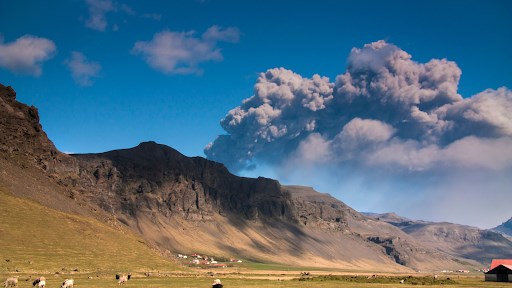Guide to Iceland’s Biggest Volcanic Eruptions
The land of ice and fire is perhaps most famous for the latter - fiery eruptions, bubbling lava, and pillars of smoke that hit the news and draw click after click every time. Just last year, a volcanic fissure near Reykjavik attracted visitors from all over the world who wanted to catch a glimpse of something so unique.
Scars from past eruptions can be seen all over the country, from lava fields to basalt columns. But which eruptions left the biggest marks? Some of the biggest volcanic eruptions weren’t as long ago as you might think!
Eyjafjallajökull 2010
If we’re discussing volcanic eruptions in Iceland, we can’t leave out the infamous Eyjafjallajökull, also known as E15. In April 2010, the eruption launched ash into the atmosphere over Europe, affecting air travel across the continent for an estimated 10 million travellers. The ash cloud rose to an incredible 9 kilometres in height, causing serious issues for aircraft visibility and turbine engines.
Holuhraun 2014
The Holuhraun eruption of 2014 and 2015 marked the biggest volcanic eruption in Iceland for around 300 years. On the 29th of August, a fissure almost 2 kilometres long opened just north of the Vatnajökull glacier, as a result of movement from the central volcano Bárðarbunga. 1.44 cubic kilometres of lava poured from the fissure in the almost 6-month-long eruption, creating a new lava field, which was named ‘Holuhraun’.

Hekla (Gate of Hell)
Since settlers first arrived in Iceland, Hekla has been a foreboding presence for all residents. Before it was clear what Hekla was, ancient Icelanders called Hekla the “Gate of Hell” due to its sudden and destructive eruptions. As recent as 2000, fire fountains and lava effusions have been features of Hekla’s eruptions, as one of the most active volcanic systems in Iceland.
Skaftáreldar 1783-84
Also known as the Laki eruption, the 1783 eruption is one of the largest ever recorded. Over 8 months, a 23-kilometre-long length of fissures and cones produced 14.7 cubic kilometres of lava. The violent eruption was not only immediately destructive but also had long-term effects, not just for Iceland, but the planet too.
Soil contamination in the direct environment led to the death of over half of the livestock in the country, and the resulting famine starved the Icelandic people, of which around ¼ died. Crops failed across Europe, Africa and India due to the volume of sulphur dioxide thrust into the atmosphere, as well as a drop in the temperature of the globe.

Eldfell 1973
The Eldfell eruption in 1973 was incredibly destructive and threatened to be even more so had residents not acted to protect the harbour. On the 23rd of January 1973, the entire island of Heimaey, the largest of the Westman Islands, was evacuated when the volcano began to erupt without prior warning. Ash from the eruption fell across the whole of Heimaey and destroyed 400 homes.
The flow of lava from the volcano headed towards the island’s harbour, threatening to cut off fishing as the main source of income for residents. Sea water was pumped onto the advancing flow, cooling it and halting its procession toward economic ruin.
Öræfajökull 1362
Öræfajökull is a stratovolcano located under the southernmost area of the Vatnajökull glacier. In 1362, the volcano erupted in a steam-blast explosion, which is common in volcanoes underneath ice caps. The region, which was previously a prosperous farming area, was completely destroyed, including around 40 farms and all inhabitants and livestock. This eruption is said to be the most deadly recorded in Iceland, second only to Skaftáreldar in 1783.
As is already evident, the inhabitants of Iceland have always combatted the effects of eruptions. While sometimes devastatingly hazardous, volcanoes create new materials, the products of which can be used to build new roads, runways, and houses. Learn more facts about Iceland’s volcanoes in our blog.
When travelling to Iceland, signs of the country’s volcanic past are truly everywhere, whether you realise it or not. Browse our rental cars today to explore the most stunning products of volcanic eruptions in 2023.

